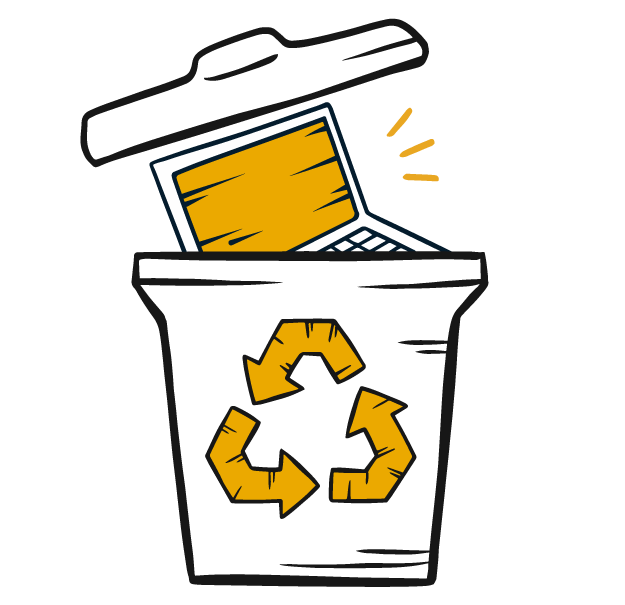
Do you understand the ways disposal of your IT hardware is impacting your business? In this article, we discuss:
When a client’s assets reach the end of their lifecycle, MSPs need a strategy to properly dispose of that hardware. With several options open to MSPs to manage the disposal of assets, it’s important to develop a consistent strategy to handle the process.
To create a strategy, MSPs first need to understand the process, their role and responsibilities, and the important factors to consider when throwing away hardware that contains sensitive data.
IT asset disposal is simply the process of disposing of hardware. Disposal commonly includes the removal of data and the sale, recycling, or destruction of that asset. How MSPs go about the disposal process can vary depending on the resources available locally and the costs associated with the IT asset disposal process.
MSPs want to develop a disposal strategy because a standardized process allows them to plan for the acquisition of new hardware that will help the client continue, or even upgrade, their operations. With a strategy, MSPs and clients will know the costs of disposal, which assets are projected to be disposed of in the future, and which assets contain sensitive data that need careful data removal.

Saving on expenses can be a big benefit for both parties, since planning in advance gives MSPs the opportunity to identify the most cost effective vendors and destruction methods for their assets.
When it comes to developing this strategy, MSPs need to consider the entire asset lifecycle of the client in question as well as their business needs and goals. Creating a standardized process can make the work fast and easy for MSP staff and keeps the client focused on their own day-to-day operations.
An IT asset disposal strategy breaks down into a few stages. It starts with identification, determining which assets are at the end of life and would no longer keep up with the clients business needs even if the warranty was renewed. Plan out what the best type of disposal method for various types of hardware will be and how data security will be maintained.
The data on these assets can be sensitive, so proper removal of the data is important, especially if those hard drives contain sensitive data like financial or medical details. Consider how storage devices will be erased or destroyed and the requirements clients are under to handle sensitive data.

Once that’s done, the logistics of removal, transportation, and disposal need to be taken care of. MSPs need to work with certified vendors. ScalePad’s IT asset disposal service makes it easy for MSPs to get rid of their hardware securely and easily. Because ScalePad’s asset disposal is free, MSPs can earn revenue by including it as a line item for all new assets, or by adding a disposal fee as part of the replacement process for end-of-life assets.
Finally, the MSP needs to keep records of the disposal process, such as data sanitation and disposal methods and maintain ongoing tracking for the next set of hardware projected to reach end-of-life.
ScalePad’s IT asset disposal service has third party validation that ensures MSPs get certificates of destruction for all of their disposal orders. MSPs and their clients can rest easy knowing their data has been properly erased.
With these steps complete, MSPs can move to their plans for asset acquisition as the next part of the IT asset lifecycle.

Streamline the asset disposal process with ScalePad’s ITAD service in Lifecycle Manager.
One of the most critical parts of the disposal process is the erasure of sensitive data. If your client works in an industry that handles sensitive data, such as financial, governmental, or medical records, they will be required by regulatory standards to make sure that data is erased or destroyed in an approved manner.

Regulations like the Health Insurance Portability and Accountability Act, (HIPAA), Payment Card Industry Data Security Standard (PCI DSS), and General Data Protection Regulation (GDPR) require data to be erased to a high standard to prevent data from being recovered from old drives.
MSPs need to make sure their data is being erased to these standards. Look to vendors that can offer disposal services to standards like the National Institute of Standards and Technology’s NIST 800-88 guidelines, such as ScalePad’s IT asset disposal program.
The asset disposal process isn’t just about getting rid of old servers and workstations, it’s also about looking ahead to the next stage in the asset lifecycle: procuring new assets. By identifying the end-of-life assets, MSPs are also identifying new questions to ask the client about their future needs and how those needs impact their budget.
Do they want to replace the equipment with modern equivalents to continue their operations as is? Are they downsizing staff and no longer need replacements? Or are they shifting business strategies and need to invest in a different type of technology? These are all vital questions that will determine long term planning and budgets.

By incorporating this lifecycle-based approach, MSPs can always be working to build on the clients business goals as part of a much larger management plan. IT asset disposal feeds back into the cycle of planning, asset procurement, deployment, maintenance, and back to disposal.
By approaching disposition with a strategic perspective, MSPs can take control of an otherwise time consuming process and be able to address their clients hardware and compliance needs as they move into a new stage in their asset lifecycle.
That’s where ScalePad IT asset disposal service comes in. Built in to Lifecycle Manager, ScalePad IT asset disposal provides users with a simple, secure, verifiable, and environmentally-friendly disposition process for decommissioned client IT assets. ScalePad IT asset disposal erases data to the NIST 880-88 standard, allowing MSPs to be sure their compliance needs are met.
Learn more about how MSPs are using Lifecycle Manager to grow their business and client relationships. Get started by watching a demo or with the free edition today.